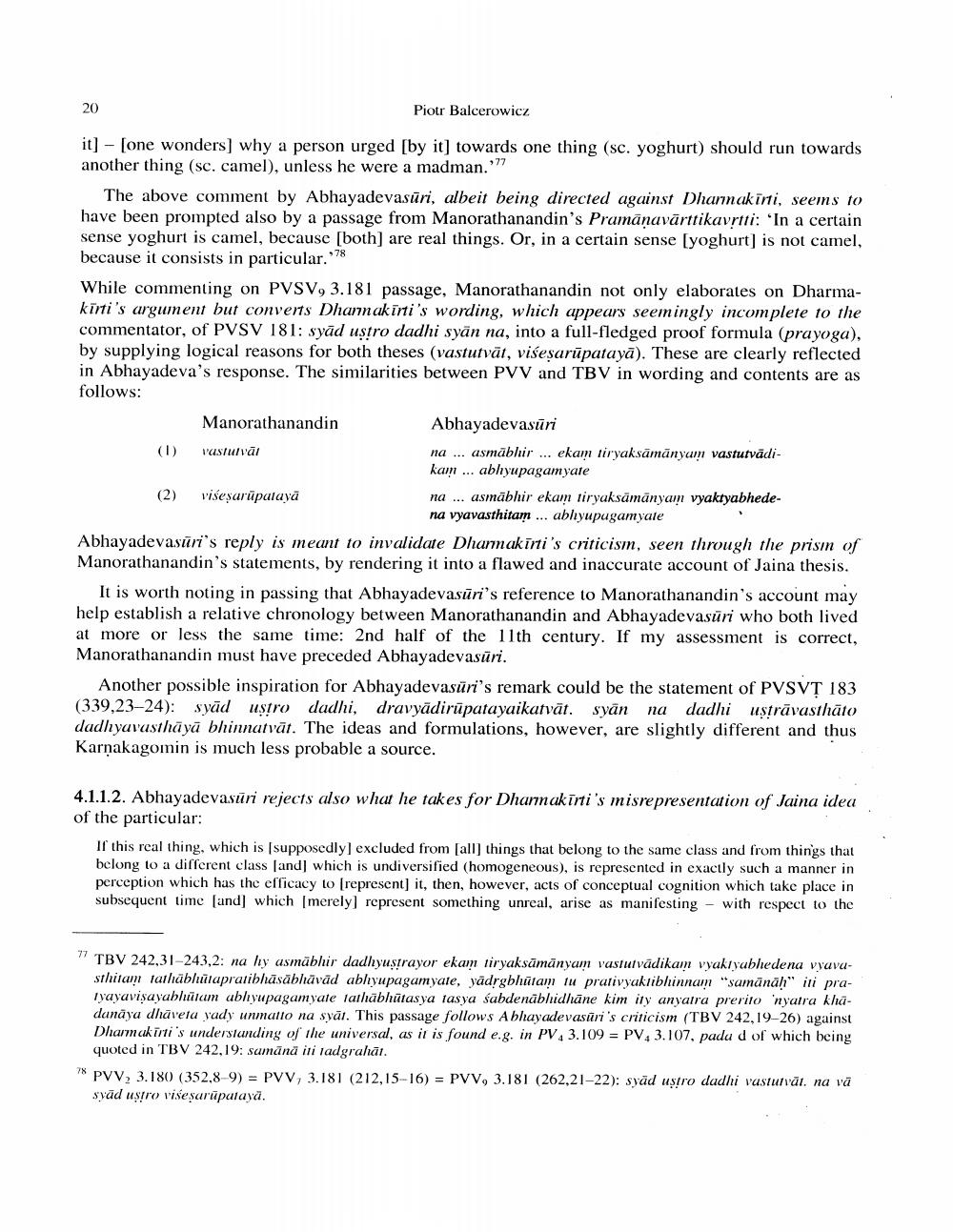________________
20
Piotr Balcerowicz
it][one wonders] why a person urged [by it] towards one thing (sc. yoghurt) should run towards another thing (sc. camel), unless he were a madman.'77
The above comment by Abhayadevasuri, albeit being directed against Dharmakirti, seems to have been prompted also by a passage from Manorathanandin's Pramāṇavārttikavṛtti: 'In a certain sense yoghurt is camel, because [both] are real things. Or, in a certain sense [yoghurt] is not camel, because it consists in particular."
78
While commenting on PVSV, 3.181 passage, Manorathanandin not only elaborates on Dharmakirti's argument but converts Dharmakirti's wording, which appears seemingly incomplete to the commentator, of PVSV 181: syad ustro dadhi syan na, into a full-fledged proof formula (prayoga), by supplying logical reasons for both theses (vastutvät, viseṣarupataya). These are clearly reflected in Abhayadeva's response. The similarities between PVV and TBV in wording and contents are as follows:
(1)
Manorathanandin
vastutvāt
Abhayadevasini
na... asmābhir ... ekam tiryaksāmānyam vastutvādikam... abhyupagamyate
na... asmābhir ekam tiryaksamanyam vyaktyabhedena vyavasthitam... abhyupugamyate
(2) viseṣarupatayā
Abhayadevasüri's reply is meant to invalidate Dharmakirti's criticism, seen through the prism of Manorathanandin's statements, by rendering it into a flawed and inaccurate account of Jaina thesis.
It is worth noting in passing that Abhayadevasūri's reference to Manorathanandin's account may help establish a relative chronology between Manorathanandin and Abhayadevasuri who both lived at more or less the same time: 2nd half of the 11th century. If my assessment is correct, Manorathanandin must have preceded Abhayadevasüri.
Another possible inspiration for Abhayadevasüni's remark could be the statement of PVSVT 183 (339,23-24): syad ustro dadhi, dravyadirupatayaikatvāt. syan na dadhi uṣtrāvasthāto dadhyavasthaya bhinnatvāt. The ideas and formulations, however, are slightly different and thus Karnakagomin is much less probable a source.
4.1.1.2. Abhayadevasüni rejects also what he takes for Dharmakirti's misrepresentation of Jaina idea of the particular.
If this real thing, which is [supposedly] excluded from [all] things that belong to the same class and from things that belong to a different class [and] which is undiversified (homogeneous), is represented in exactly such a manner in perception which has the efficacy to [represent] it, then, however, acts of conceptual cognition which take place in subsequent time [and] which [merely] represent something unreal, arise as manifesting with respect to the
77 TBV 242,31-243,2: na hy asmabhir dadhyuştrayor ekam tiryaksāmanyam vastutvādikam vyakıyabhedena vyavasthitam tathabhutapratibhasabhävad abhyupagamyate, yadṛgbhūtam tu prativyaktibhinnam "samānāḥ" ili praIyayaviṣayabhutam abhyupagamyate tathabhutasya tasya sabdenābhidhane kim ity anyatra prerito 'nyatra khadanaya dhäveta yady unmatto na syat. This passage follows Abhayadevasuri's criticism (TBV 242,19-26) against Dharmakirti's understanding of the universal, as it is found e.g. in PV4 3.109 PV4 3.107, pada d of which being quoted in TBV 242,19: samana iti tadgrahat.
78 PVV2 3.180 (352,8-9)= PVV, 3.181 (212,15-16) PVV, 3.181 (262,21-22): syad ustro dadhi vastutvāt. na vā syad ustro viseṣarupataya.




